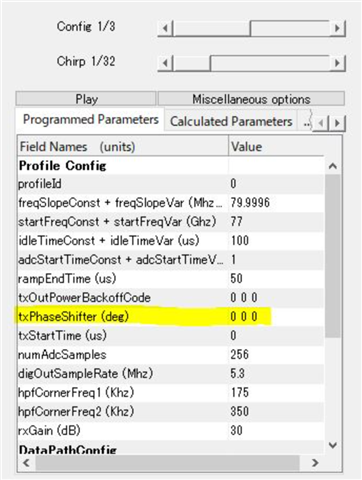Tool/software:
To the TI Support Team,
Thank you for your support.
Please note that this message was translated using AI.
We are currently evaluating the chirp-based phase shifter feature using mmWave Studio, DCA1000, and IWR1843AOP.
[Request]
We would like to use the “Chirp based Phase Shifter” feature in BPMConfig.
[Steps Taken]
We connected the DCA1000 and IWR1843AOP to mmWave Studio.
First, we enabled “Per Chirp Phase Shifter En” in the Radar Miscellaneous Control section of the StaticConfig tab.
Next, we configured the phase shift settings. For a simplified functional check, we set the following parameters:
[13:32:09] [RadarAPI]: Status: Passed
[13:32:09] [RadarAPI]: ar1.ChirpConfig(1, 1, 0, 0, 0, 0, 0, 0, 1, 0)
[13:32:09] [RadarAPI]: Status: Passed
[13:32:09] [RadarAPI]: ar1.ChirpConfig(2, 2, 0, 0, 0, 0, 0, 0, 0, 1)
[13:32:09] [RadarAPI]: Status: Passed
[13:33:10] [RadarAPI]: ar1.SetPerChirpPhaseShifterConfig(0, 0, 20, 0, 0)
[13:33:10] [RadarAPI]: Status: Passed
[13:33:10] [RadarAPI]: ar1.SetPerChirpPhaseShifterConfig(1, 1, 0, 20, 0)
[13:33:10] [RadarAPI]: Status: Passed
[13:33:10] [RadarAPI]: ar1.SetPerChirpPhaseShifterConfig(2, 2, 0, 0, 20)
[13:33:10] [RadarAPI]: Status: Passed
Next, we acquired ADC data using the following steps under Capture and Post Processing in the SensorConfig tab:
DCA1000 ARM → Trigger Frame → Stop Frame → PostProc
We have attached the result. In the attached screenshot, although we expected phase shifts to be applied, the phase shift values for all TX antennas remain “0” across all chirps.
[Questions]
-
How can we correctly use the chirp-based phase shift feature?
Are the procedures we followed correct?
-
Is it possible to confirm that the phase shifts have been properly applied within mmWave Studio?
(For example, as shown in the attached screenshot, is it not possible to determine whether the phase shift is working correctly just by checking the “txPhaseShifter(deg)” values?)
We do have access to evaluation equipment such as a radar target simulator, but it is not readily available for use at the moment. Therefore, we would like to know if there is any way to verify the phase shifts using only mmWave Studio.
Before submitting this question, we referred to the following E2E thread and applied the suggested configurations. However, the phase shift still does not appear to be applied correctly, so we are reaching out for further guidance:
https://e2e.ti.com/support/sensors-group/sensors/f/sensors-forum/1422818/iwr6843isk-ods-chirp-based-phase-shifter-in-tdm-mode/5463923?tisearch=e2e-sitesearch&keymatch=chirp%252520phase#5463923
Thank you very much for your support.
Best regards,


